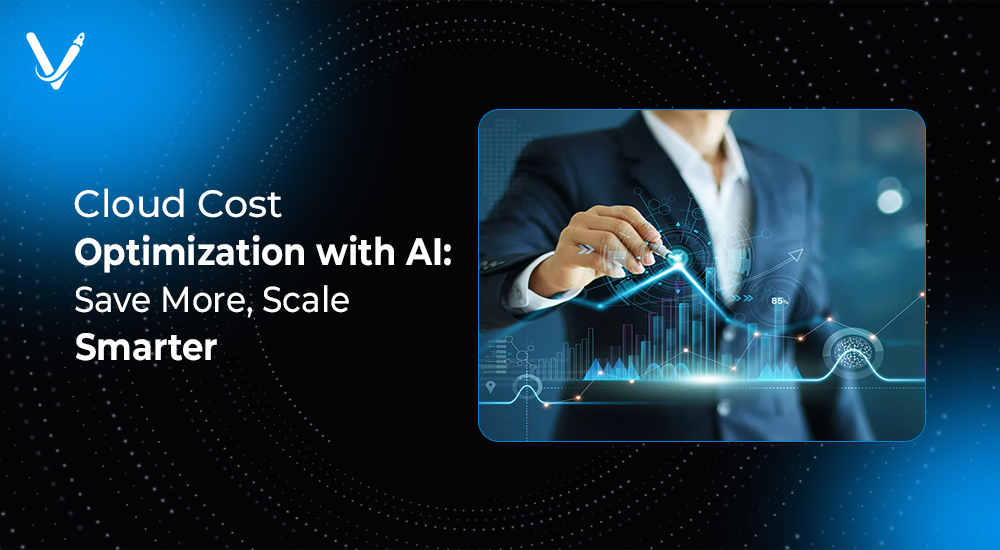Cloud Cost Optimization with AI: Save More, Scale Smarter


- Aug 25, 2025



Cloud computing has transformed how businesses operate. It offers unmatched scalability, flexibility, and global reach that traditional infrastructure could never provide. However, this power comes with a price—often a hefty one. Many organizations find themselves spending more on the cloud than initially planned, with costs spiraling due to underutilized resources, poor forecasting, or complex pricing models.
This is where artificial intelligence (AI) comes into play. Cloud cost optimization with AI is not just about reducing bills; it’s about making smarter, data-driven decisions that ensure every dollar spent delivers maximum value. By combining the agility of cloud infrastructure with the intelligence of AI, companies can strike the perfect balance between saving money and scaling operations efficiently.
In this comprehensive article, we’ll explore the fundamentals of cloud cost optimization, the role AI plays in transforming cloud management, practical strategies businesses can adopt, and real-world use cases proving its impact. We’ll also look at the tools, challenges, and future trends shaping AI-driven cloud financial management.
Before understanding how AI improves cloud spending, it’s important to recognize why cloud cost optimization is such a critical business priority. Cloud costs can spiral out of control quickly if left unmanaged, leading to wasted budgets and missed opportunities for innovation.
Cloud adoption has accelerated across industries, but managing costs is a growing challenge. With multiple services, dynamic workloads, and distributed architectures, visibility into spending becomes difficult. Left unchecked, this leads to:
Ineffective cloud spending doesn’t just hurt finances—it impacts growth. High costs can limit innovation budgets, slow down expansion plans, and create friction between IT and finance teams. Moreover, in competitive markets, every wasted dollar reduces margins and weakens competitiveness.
The concept of FinOps—Financial Operations—has emerged to bring financial accountability to the cloud. It emphasizes collaboration between engineering, finance, and operations to optimize spending. AI supercharges this approach by automating insights, predicting usage, and recommending optimizations in real time.
AI has changed the way organizations manage infrastructure. Instead of reactive cost monitoring, AI enables proactive, automated optimization that continuously adapts to workloads and usage trends.
Traditional cost control relies heavily on manual monitoring, static rules, and spreadsheets. These methods cannot keep up with the speed and complexity of today’s multi-cloud environments. AI transforms this approach by analyzing large datasets, detecting inefficiencies, and dynamically adjusting resource allocation.
Instead of replacing cloud architects or financial teams, AI acts as a co-pilot. It surfaces insights humans might miss, reduces manual effort, and enables teams to focus on higher-level strategy.
Once the benefits of AI in cloud management are understood, the next step is learning how to apply it effectively. Businesses can use AI across different areas of cloud infrastructure to eliminate waste and enhance efficiency.
AI can analyze performance metrics and recommend the best instance sizes. Instead of over-provisioning resources “just in case,” organizations can ensure workloads get exactly what they need.
Unused resources during non-business hours are a common cost drain. AI-powered scheduling automatically turns off instances when not in use, drastically cutting costs without affecting productivity.
Cloud providers like AWS, Azure, and Google Cloud offer discounted spot instances. AI can manage these volatile resources, ensuring workloads migrate seamlessly when spot instances are reclaimed, maximizing savings.
AI identifies rarely accessed data and moves it to cheaper storage tiers, such as cold or archival storage, without affecting accessibility for critical workloads.
Enterprises often use multiple cloud providers. AI evaluates real-time costs, performance metrics, and compliance requirements to suggest the best cloud for each workload.
AI can integrate into development pipelines to highlight resource-heavy code changes, enabling teams to address inefficiencies before deployment.
The true value of AI-driven cost optimization becomes clear when examining how it impacts specific industries. From e-commerce to healthcare, businesses across sectors are realizing measurable savings.
Online retailers face unpredictable traffic spikes during holidays and promotions. AI-driven auto-scaling ensures systems handle demand surges efficiently while minimizing idle resource costs during off-peak times.
Software-as-a-Service providers depend on cloud infrastructure for product delivery. AI helps them predict customer usage, optimize multi-tenant environments, and maintain profitability without compromising performance.
Banks and fintech firms handle massive amounts of data that require scalable compute and storage. AI-powered anomaly detection prevents unexpected billing shocks while ensuring compliance with regulatory requirements.
Hospitals and research institutions manage sensitive, data-heavy workloads. AI enables secure, cost-effective storage management and efficient workload distribution for analytics and AI-driven diagnostics.
Cloud gaming platforms must deliver high performance globally while keeping costs manageable. AI optimizes GPU usage and manages dynamic scaling for a smoother user experience.
Understanding the advantages of AI in cloud cost management goes beyond financial savings. It creates operational, financial, and strategic improvements that benefit the entire organization.
While AI offers immense promise, organizations often encounter roadblocks when trying to implement it effectively. Addressing these challenges is crucial to achieving sustainable success.
AI relies on accurate data. Inconsistent or incomplete usage logs can reduce optimization accuracy.
Organizations often use a mix of monitoring platforms, billing dashboards, and governance tools. Ensuring AI integrates smoothly with this ecosystem is crucial.
Cost reduction should never come at the expense of user experience. AI must strike the right balance between savings and reliability.
Teams need expertise in both AI and cloud management to effectively implement these solutions. Upskilling or partnering with external experts is often necessary.
A wide range of platforms exist to help companies implement AI-powered cost optimization. These include both native cloud provider tools and third-party solutions that integrate across multiple ecosystems.
The evolution of AI is shaping the future of cloud financial management. Companies that embrace these emerging trends will be able to unlock even greater efficiency and sustainability.
Future systems may operate with minimal human intervention, automatically allocating and deallocating resources while continuously learning from usage patterns.
Advanced AI models will simulate potential workload scenarios, helping organizations test cost strategies before implementing them.
AI won’t just cut costs; it will help businesses reduce carbon footprints by shifting workloads to greener regions and minimizing energy consumption.
Enterprises may soon leverage AI to analyze pricing models and negotiate better contracts with cloud vendors.
Transitioning to AI-driven cloud cost optimization doesn’t have to be overwhelming. Organizations can take a structured approach to gradually implement best practices while minimizing risk.
Cloud cost optimization with AI is more than a cost-cutting exercise—it’s a strategic move that empowers businesses to innovate and scale without financial strain. By leveraging AI’s predictive capabilities, automation, and real-time insights, organizations can achieve smarter spending, improved performance, and sustainable growth in the cloud era.
At Vasundhara Infotech, we help businesses harness the power of AI to make cloud investments more efficient, scalable, and future-ready. If you’re looking to optimize your cloud costs while building a smarter infrastructure, our team is ready to guide you. Get in touch with us.
Copyright © 2026 Vasundhara Infotech. All Rights Reserved.